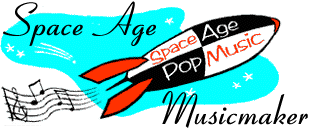Home · Listener's Guide · The Songs · Who's Who · Liner Notes · Selected Tracks · What's New · Search

Carroll Bratman
- Born 27 June 1906, Baltimore, Maryland
- Died 15 July 1984, New York City
Many of the musicians remembered on this were heard but not seen--playing on hundreds or thousands of tracks without a cover credit. Carroll Bratman was neither heard nor seen on any of these. So why mention him? Because he had an influence on space age pop that was, in its way, as significant as that of any performer, composer, or arranger.
Carroll Bratman rented percussion instruments.
OK, you're thinking ... so why mention him?
Well, if I may be so bold, without Carroll Bratman, there would have been a lot less space-agey about space age pop. Without the panoply of percussion instruments rented out Phil Kraus and other crack studio percussionists, space age pop would have been ... well, easy listening. Just imagine what one of Enoch Light's Command Persuasive [e.g.] Percussion albums would have sounded like without the buzzimba, chromatic bongos, Chinese bell tree, jawbone, and gong. Yep, pretty lame.
And where did all those wacky instruments come from? If the track was cut in New York City, it was Carroll Music, the company Bratman formed in 1945. That alone merits a mention, if not a decent write-up. But Bratman's contribution was much more than the instruments, for he inspired, nutured, cultivated, and supported a whole generation of percussionists and other musicians. Carroll Music wasn't just where you rented the buzzimba. It was where percussionists hung out, where Bratman would bring out his latest acquisition and everyone would gather around and figure out how to play it. On more than one occasion, Carroll Music became a performance space, and in at least one case, a recording studio.
In 1955, Kraus, Harry Breuer, Terry Snyder, Willie Rodriguez, and a handful of other percussionists gathered there to record a set of tunes written by Jimmy Carroll for percussion ensembles. The album, Speed the Parting Guest, was a seminal recording. Released by the tiny but highly-regarded Cook Laboratories label, a pioneer in high fidelity recordings, the album became known among hi-fi buffs as an acid test for a system, and eventually, bigger labels took notice and began producing their own percussion-packed records. And the percussionists themselves began to see that their part could be as important as that of any of the high-profile instruments, and within a year or two, many of them had cut their own albums.
But Bratman's influence went even further. Novelty instruments of any type fascinated him. On word of mouth alone, he encouraged a young Jean Jacques Perrey to tape some of his compositions for the Ondioline, and on the strength of the tape alone, he sent Perrey round trip plane tickets from Paris to New York with "Come" written on the ticket jacket. Bratman sponsored Perrey's green card, got him admitted to the Musicians' Union, put him on salary, got him spots performing his "magic instrument" on television shows,and gave him free rein with his own studio, the best tape recorders on the market, and any of the Carroll Music instruments he wanted. He paired Perrey up with Harry Breuer, who helped him create soundtracks for radio and television commercials with his Ondioline and tape splicing, and then to Angelo Badalamenti and Gershon Kingsley, with whom he recorded another seminal space age pop album, The In Sound from Way Out.
Bratman was a working percussionist himself for over 20 years before he formed Carroll Music. Raised in Baltimore, he attended the Peabody Conservatory there and was playing with the Baltimore Symphony before he turned twenty. In 1930, he was invited to join the newly-formed National Symphony, and he stayed with them for over ten years. At the same time, he continued his studies at the Curtis Institute in Philadelphia and ran a dance band with his brother in Baltimore, shuttling back and forth between the three cities. He then switched from classsical to popular music, becoming a studio musician in New York City, first with NBC and later with CBS.
He had begun collecting percussion instruments while with the National Symphony, and by 1945, found he was spending so much time loaning pieces from his collection out to studio, stage, and symphony ensembles that he decided to rent some space and start Carroll Music as a full-time business.
From that day on, Carroll Music has been at the center of the New York percussion community. Bratman knew all the musicians, whether with the New York Philharmonic, or a television band, or as a freelance studio player. He donated part of his collection to the Percussive Arts Society not long before his death. Carroll Music carries on in his name, and his spirit lives on in the cacophony of percussion sounds to be heard on space age pop recordings great and small.
S p a c e A g e P o p M u s i c
Home · Listener's Guide · The Songs · Who's Who · Liner Notes · Selected Tracks · What's New · Search
Email: editor@spaceagepop.com